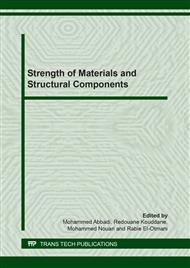[1]
Reda Agnaou. Semi-crystalline supramolecular polymers based on polyamides and PMMA. Physical chemistry [physics.chem-ph]. Université Pierre et Marie Curie - Paris VI, (2014).
Google Scholar
[2]
A. En-naji et al; change of experimental elongations with increasing temperature for an abs material subjected to tensile test; International Journal of Mechanical Engineering and Technology (IJMET).
Google Scholar
[3]
G. M. Domínguez Almaraz Crack initiation and propagation on the polymeric material ABS (Acrylonitrile Butadiene Styrene), under ultrasonic fatigue testing Fratturaed Integrità Strutturale, 34 (2015) 498-506;.
DOI: 10.3221/igf-esis.34.55
Google Scholar
[4]
Ribeiro MCS, Novoa PR, Ferreira AJM and Marques AT. Flexural performance of polyester and epoxy polymer mortars under severe thermal conditions. Cement and Concrete Composites. 2004; 26: 803-809.
DOI: 10.1016/s0958-9465(03)00162-8
Google Scholar
[5]
Shokrieh MM, Heidari-Rarani M, Shakouri M and Kashizadeh E. Effects of thermal cycles on mechanical properties of an optimized polymer concrete. Construction and Building Materials. 2011; 25:3540-3549.
DOI: 10.1016/j.conbuildmat.2011.03.047
Google Scholar
[6]
Elalaoui O, Ghorbel E, Mignot V and Ben Ouezdou M. Mechanical and physical properties of epoxy polymer concrete after exposure to temperatures up to 250 ºC. Construction and Building Materials. 2012; 27:415-424.
DOI: 10.1016/j.conbuildmat.2011.07.027
Google Scholar
[7]
Letsch R. Behaviour of polymers and polymer mortars at constant and changing temperatures. In: Proceedings of the 10th International Congress on Polymers in Concrete; 2001; Honolulu, Hawaii. Honolulu; (2001).
Google Scholar
[8]
B. Ni, J. Li et V. Berry, «Plastic zone in front of a mode I crack in acrylonitrile-butadiene-styrene.
Google Scholar
[9]
C. Bathias, J. Bailon, The fatigue of materials and structures, pp.328-330. (1980).
Google Scholar
[10]
ASTM D638-03 Standard test method for tensile properties of plastics.
Google Scholar
[11]
F. HICHAM Behavior and damage of thermoplastic membranes in large deformations thesis pp.55-78.
Google Scholar
[12]
A. EN-NAJI et al Change of experimental young's modulus with increasing temperature for an abs material subjected to tensile test: ARPN Journal of Engineering and Applied Sciences; 2006-2019 Asian Research Publishing Network (ARPN). All rights reserved; VOL. 14, NO. 3, FEBRUARY2019 ISSN 1819-6608.
Google Scholar
[13]
R. Rhanim et al Mechanical behavior study of an ABS's sample damaged artificially ISSN 2028-9324 Vol. 17 No. 2 Jul. 2016, pp.698-706.
Google Scholar
[14]
Abderazzak Ouardi, Residual life prediction of defected Polypropylene Random copolymer pipes (PPR), Frattura ed Integrità Strutturale, 43 (2018) 97-105;.
DOI: 10.3221/igf-esis.43.07
Google Scholar
[15]
Fatima Majid, Mohamed Elghorba" HDPE pipes failure analysis and damage modeling" (2016),.
Google Scholar
[16]
M. Chahid, G. M. El, M. Benhamouet Z. Azari, «Reliability optimization of fatigue damage of a glass-epoxy composite material, »Materials and techniques, vol. 84, pp.13-17, (1996).
Google Scholar
[17]
Dubuc, J., et al. Unified theory of cumulative damage in metal fatigue (Cumulative damage in metal fatigue, suggesting unified theory applicable to stress or strain controlled conditions).WRC Bulletin, (1971) 1-20.
DOI: 10.1115/1.3425328
Google Scholar
[18]
A. En-naji et al, Prediction of thermomechanical behavior of acrylonitrile butadiene styrene using a newly developed nonlinear damage-reliability model; Frattura ed Integrità Strutturale, 49 (2019) 748-762;.
DOI: 10.3221/igf-esis.49.67
Google Scholar


